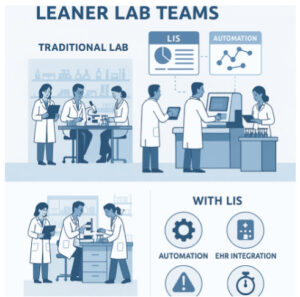Clinical laboratories across the country are facing a persistent challenge: staffing shortages. Whether due to retirements, burnout, or a lack of new graduates, the pressure on lab teams continues to mount. But while the qualified candidate pipeline may be shrinking, the demand for accurate, timely diagnostics is growing. To stay ahead, labs must turn to technology—specifically, Laboratory Information Systems (LIS)—to do more with less.
The Staffing Crisis in Numbers
According to the American Society for Clinical Pathology, vacancy rates in medical labs range from 5% to more than 10%, depending on the region.1 The U.S. Bureau of Labor Statistics projects a 7% growth in the field by 2031, further intensifying the need for skilled professionals. With this backdrop, labs must find ways to maintain quality and efficiency without increasing headcount. 
LIS: The Backbone of Lean Lab Operations
A well-integrated LIS can be a game-changer. By automating routine tasks—such as test ordering, result delivery, and data reporting—labs can reduce manual workload and free up staff to focus on high-value activities. Integration with Electronic Health Records (EHRs) ensures seamless data flow, eliminating the need for faxing or manual entry.
Orchard Software’s Enterprise LIS software exemplifies this approach. Designed to streamline workflows, promote interoperability, and boost productivity, it helps labs operate efficiently even when understaffed. As noted in MLO’s LIS Guide, “Labs are turning to technology to gain workflow efficiencies and adopt more automation.”2
Real-World Impact
In our recent white paper, we highlight automation as a key strategy for managing increasing workloads and reducing errors. Lean processes combined with LIS automation allow labs to maintain high standards of patient care despite staffing constraints.
Laboratory managers are actively seeking peer networking and innovation to address staffing, cost, and revenue challenges. Strategic roundtables and webinars have become platforms for sharing best practices and exploring LIS-driven solutions.
Looking Ahead
As labs continue to evolve, the role of the LIS will continue to grow. From supporting remote operations to enabling digital pathology workflows, LIS technology is central to lab strategy. The key is not just having a system—but having the right system and using it to its full potential.
References
- Garcia E, Kundu I, Kelly M, Soles R. The American Society for Clinical Pathology 2022 Vacancy Survey of medical laboratories in the United States. Am J Clin Pathol. 2024;161(3):289–304. doi:10.1093/ajcp/aqad149
- Brady E. State of the 2024 LIS market. MLO. Oct. 2024. https://www.mlo-online.com/information-technology/lis/article/55233738/state-of-the-2024-lis-market
